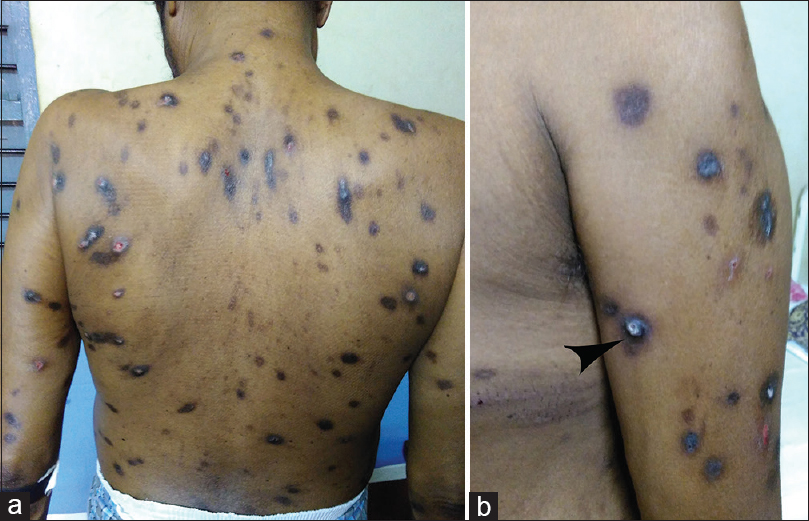Translate this page into:
Acquired perforating dermatosis in a diabetic patient on hemodialysis
This is an open access article distributed under the terms of the Creative Commons Attribution-NonCommercial-ShareAlike 3.0 License, which allows others to remix, tweak, and build upon the work non-commercially, as long as the author is credited and the new creations are licensed under the identical terms.
This article was originally published by Medknow Publications & Media Pvt Ltd and was migrated to Scientific Scholar after the change of Publisher.
Acquired perforating dermatosis is a group of disorders with transepidermal elimination of collagen, elastic tissue, or necrotic connective tissue seen in one-tenth of hemodialysis patients.[1]
A 57-year-old patient with end stage kidney disease due to diabetes had been on twice weekly hemodialysis through left radiocephalic arteriovenous fistula for 1½ years. He gave history of recurrent episodes of intensely pruritic rashes all over the body during last 1-year.
On examination, he showed multiple discrete hyperpigmented lesions over the trunk, both arms and thighs [Figure 1a] with few lesions having central keratotic papules [arrowhead in Figure 1b]. Some lesions were inflamed suggestive of secondary infection. There were multiple itch marks and linear pattern of skin lesions over the right thigh suggestive of Koebner's phenomenon. A diagnosis of acquired perforating dermatosis was made, and the patient was started on oral antibiotics, antihistamines, topical steroid, and emollients. The skin lesions healed with scarring. Three months later, the patient again had a fresh bout of similar lesions. The patient was started again on topical steroids and antihistamines. The patient was lost to follow-up.

- Multiple hyperpigmented papules over the back (panel a) and arm with central keratotic plug (panel b)
Skin manifestations in chronic kidney disease can be nonspecific or specific to the kidney disease. Nonspecific manifestations are pruritus, ichthyosis, xerosis, pigmentary changes, and half-and-half nails. Specific manifestations include uremic frost, acquired perforating dermatosis, blistering disorders, calciphylaxis, metastatic calcification, and nephrogenic systemic fibrosis.[2]
Acquired perforating dermatosis is usually associated with diabetes mellitus and chronic kidney disease often after initiation of dialysis. However, it has been also reported in transplant recipients, nondiabetic hemodialysis patients, and chronic kidney disease patients not yet on dialysis.[3] Acquired perforating disorders are divided into four diseases according to the type of epidermal disruption and the nature of the eliminated material: Kyrle's disease, perforating folliculitis, elastosis perforans serpiginosa, and reactive perforating collagenosis.[4]
The exact pathophysiology is unknown. Localized skin irritation, typically from scratching, may cause an inflammatory cutaneous reaction to uremic substrates in the dermis, leading to lesion formation.[5]
Patients present with moderate to severe pruritus in the affected skin areas and characteristically have pruritic, firm, dome-shaped papules or nodules with a central keratotic plug distributed on the extensor surfaces of the extremities and trunk. Individual lesions are crateriform, umbilicated, or centrally hyperkeratotic papules and nodules. Palms and soles were mostly spared.[2] Koebnerization (formation of lesions in areas of skin trauma, most notably from scratching) is common. Lesions may develop in crops and resolve after 6–8 weeks with scarring.
The diagnosis of is made on clinicalgrounds and confirmed with a lesional skin biopsy.[2] Histologically, these disorders are characterized by the transepidermal elimination of dermal substrates, such as collagen, keratin, and elastic fibers.[6] Differential diagnosis includes verruca vulgaris, eruptive keratoacanthoma, hypertrophic lichen planus, follicular keratosis, phrynoderma, prurigo nodularis, benign nodular calcification (calcinosis cutis), and calciphylaxis.[7]
APD can be differentiated from calciphylaxis by the presence of intensely pruritic papules or nodules most commonly in lower limbs in the former whereas calciphylaxis starts as violaceous mottling that progress to severely painful plaques or nodules and subsequently become necrotic ulcers covered by eschars often in the lower extremities, abdomen and buttocks, both of which have large amounts of subcutaneous fat.[2] Histologically, calciphylaxis is characterized by medial calcification and thrombosis of blood vessels in the dermis and subcutaneous tissue and APD by the transepidermal elimination of dermal structures.[2]
Treatment is often frustrating as lesions can persist, and chronic scars can develop.[8] The most commonly reported treatments were topical and intralesional steroids, oral antihistamines, and topical retinoids. Others include narrow band ultraviolet B, psoralen plus ultraviolet A, oral retinoid, and cryotherapy.
As chronic kidney disease patients are living longer, the incidence of these cutaneous diseases will likely increase, thereby affecting the quality of life. Therefore, physicians need to have a high index of suspicion in patients with diabetes along with concomitant chronic kidney disease.
Financial support and sponsorship
Nil.
Conflicts of interest
There are no conflicts of interest.
References
- Diagnosis of common dermopathies in dialysis patients: A review and update. Semin Dial. 2012;25:408-18.
- [Google Scholar]
- Dermatological diseases in patients with chronic kidney disease. J Nephropathol. 2013;2:104-9.
- [Google Scholar]
- Kyrle's disease in a patient of diabetes mellitus and chronic renal failure on dialysis. J Family Med Prim Care. 2015;4:284-6.
- [Google Scholar]
- Acquired perforating dermatoses in patients with diabetic kidney disease on hemodialysis. Hemodial Int. 2010;14:73-7.
- [Google Scholar]
- Acquired perforating dermatosis in patients with chronic renal failure and diabetes mellitus. J Korean Med Sci. 2004;19:283-8.
- [Google Scholar]
- Cutaneous manifestations of end-stage renal disease. J Am Acad Dermatol. 2000;43:975-86.
- [Google Scholar]






